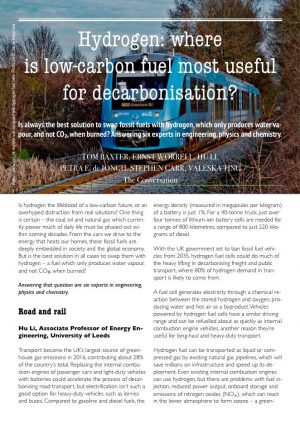 Is hydrogen the lifeblood of a low-carbon future, or an overhyped distraction from real solutions? One thing is certain – the coal, oil and natural gas which currently power much of daily life must be phased out within coming decades. From the cars we drive to the energy that heats our homes, these fossil fuels are deeply embedded in society and the global economy. But is the best solution in all cases to swap them with hydrogen – a fuel which only produces water vapour, and not CO₂, when burned?Answering that question are six experts in engineering, physics and chemistry.
Is hydrogen the lifeblood of a low-carbon future, or an overhyped distraction from real solutions? One thing is certain – the coal, oil and natural gas which currently power much of daily life must be phased out within coming decades. From the cars we drive to the energy that heats our homes, these fossil fuels are deeply embedded in society and the global economy. But is the best solution in all cases to swap them with hydrogen – a fuel which only produces water vapour, and not CO₂, when burned?Answering that question are six experts in engineering, physics and chemistry.
Road and rail
Hu Li, Associate Professor of Energy Engineering, University of Leeds
Transport became the UK’s largest source of greenhouse gas emissions in 2016, contributing about 28% of the country’s total. Replacing the internal combustion engines of passenger cars and light-duty vehicles with batteries could accelerate the process of decarbonising road transport, but electrification isn’t such a good option for heavy-duty vehicles such as lorries and buses. Compared to gasoline and diesel fuels, the energy density (measured in megajoules per kilogram) of a battery is just 1%. For a 40-tonne truck, just over four tonnes of lithium-ion battery cells are needed for a range of 800 kilometres, compared to just 220 kilograms of diesel. With the UK government set to ban fossil fuel vehicles from 2035, hydrogen fuel cells could do much of the heavy lifting in decarbonising freight and public transport, where 80% of hydrogen demand in transport is likely to come from. A fuel cell generates electricity through a chemical reaction between the stored hydrogen and oxygen, producing water and hot air as a byproduct. Vehicles powered by hydrogen fuel cells have a similar driving range and can be refuelled about as quickly as internal combustion engine vehicles, another reason they’re useful for long-haul and heavy-duty transport. Hydrogen fuel can be transported as liquid or compressed gas by existing natural gas pipelines, which will save millions on infrastructure and speed up its deployment. Even existing internal combustion engines can use hydrogen, but there are problems with fuel injection, reduced power output, onboard storage and emissions of nitrogen oxides (NOₓ), which can react in the lower atmosphere to form ozone – a greenhouse gas. The goal should be to eventually replace internal combustion engines with hydrogen fuel cells in vehicles that are too large for lithium-ion batteries. But in the meantime, blending with other fuels or using a diesel-hydrogen hybrid could help lower emissions. It’s very important to consider where the hydrogen comes from though. Hydrogen can be produced by splitting water with electricity in a process called electrolysis. If the electricity was generated by renewable sources such as solar and wind, the resulting fuel is called green hydrogen. It can be used in the form of compressed gas or liquid and converted to methane, methanol, ammonia and other synthetic liquid fuels. But nearly all of the 27 terawatt-hours (TWh) of hydrogen currently used in the UK is produced by reforming fossil fuels, which generates nine tonnes of CO₂ for every tonne of hydrogen. This is currently the cheapest option, though some experts predict that green hydrogen will be cost-competitive by 2030. In the meantime, governments will need to ramp up the production of vehicles with hydrogen fuel cells and storage tanks and build lots of refuelling points. Hydrogen can play a key role in decarbonising rail travel too, alongside other low-carbon fuels, such as biofuels. In the UK, 6,049 kilometres of mainline routes run on electricity – that’s 38% of the total. Trains powered by hydrogen fuel cells offer a zero-emission alternative to diesel trains. The Coradia iLint, which entered commercial service in Germany in 2018, is the world’s first hydrogen-powered train. The UK recently launched mainline testing of its own hydrogen-powered train, though the UK trial aims to retrofit existing diesel trains rather than design and build entirely new ones.
Aviation
Valeska Ting, Professor of Smart Nanomaterials, University of Bristol
Of all of the sectors that we need to decarbonise, air travel is perhaps the most challenging. While cars and boats can realistically switch to batteries or hybrid technologies, the sheer weight of even the lightest batteries makes long-haul electric air travel tricky. Single-seat concept planes such as the Solar Impulse generate their energy from the sun, but they can’t generate enough based on the efficiency of current solar cells alone so must also use batteries. Other alternatives include synthetic fuels or biofuels, but these could just defer or reduce carbon emissions, rather than eliminate them altogether, as a carbon-free fuel like green hydrogen could. Hydrogen is extremely light and contains three times more energy per kilogram than jet fuel, which is why it’s traditionally used to power rockets. Companies including Airbus are already developing commercial zero-emission aircraft that run on hydrogen. This involves a radical redesign of their fleet to accommodate liquid hydrogen fuel tanks. There are some technical challenges though. Hydrogen is a gas at room temperature, so very low temperatures and special equipment are needed to store it as a liquid. That means more weight, and subsequently, more fuel. However, research we’re doing at the Bristol Composites Institute is helping with the design of lightweight aircraft components made out of composite materials. We’re also looking at nanoporous materials that behave like molecular sponges, spontaneously absorbing and storing hydrogen at high densities for onboard hydrogen storage in future aircraft designs. France and Germany are investing billions in hydrogen-powered passenger aircraft. But while the development of these new aircraft by industry continues apace, international airports will also need to rapidly invest in infrastructure to store and deliver liquid hydrogen to refuel them. There’s a risk that fleets of hydrogen aeroplanes could take off before there’s a sufficient fuel supply chain to sustain them.
Heating
Tom Baxter, Honorary Senior Lecturer in Chemical Engineering, University of Aberdeen & Ernst Worrell, Professor of Energy, Resources and Technological Change, Utrecht University
If the All Party Parliamentary Group on Hydrogen’s recommendations are taken up, the UK government is likely to support hydrogen as a replacement fuel for heating buildings in its next white paper. The other option for decarbonising Britain’s gas heating network is electricity. So which is likely to be a better choice – a hydrogen boiler in every home or an electric heat pump? First there’s the price of fuel to consider. When hydrogen is generated through electrolysis, between 30-40% of the original electric energy is lost. One kilowatt-hour (kWh) of electricity in a heat pump may generate 3-5 kWh of heat, while the same kWh of electricity gets you only 0.6-0.7 kWh of heat with a hydrogen-fuelled boiler. This means that generating enough hydrogen fuel to heat a home will require electricity generated from four times as many turbines and solar panels than a heat pump. Because heat pumps need so much less energy overall to supply the same amount of heat, the need for large amounts of stored green energy on standby is much less. Even reducing these losses with more advanced technology, hydrogen will remain relatively expensive, both in terms of energy and money. So using hydrogen to heat homes isn’t cheap for consumers. Granted, there is a higher upfront cost for installing an electric heat pump. That could be a serious drawback for cash-strapped households, though heat pumps heat a property using around a quarter of the energy of hydrogen. In time, lower fuel bills would more than cover the installation cost. Replacing natural gas with hydrogen in the UK’s heating network isn’t likely to be simple either. Per volume, the energy density of hydrogen gas is about one-third that of natural gas, so converting to hydrogen will not only require new boilers, but also investment in grids to increase how much fuel they can deliver. The very small size of hydrogen molecules mean they’re much more prone to leaking than natural gas molecules. Ensuring that the existing gas distribution system is fit for hydrogen could prove quite costly. In high-density housing in inner cities, district heating systems – which distribute waste heat from power plants and factories into homes – could be a better bet in a warming climate, as, like heat pumps, they can cool homes as well as heat them. Above all, this stresses the importance of energy efficiency, what the International Energy Agency calls the first fuel in buildings. Retrofitting buildings with insulation to make them energy efficient and switching boilers for heat pumps is the most promising route for the vast majority of buildings. Hydrogen should be reserved for applications where there are few or no alternatives. Space heating of homes and buildings, except for limited applications like in particularly old homes, is not one of them.
Electricity and energy storage
Petra de Jongh, Professor of Catalysts and Energy Storage Materials, Utrecht University
Fossil fuels have some features that seem impossible to beat. They’re packed full of energy, they’re easy to burn and they’re compatible with most engines and generators. Producing electricity using gas, oil, or coal is cheap, and offers complete certainty about, and control over, the amount of electricity you get at any point in time. Meanwhile, how much wind or solar electricity we can generate isn’t something that we enjoy a lot of control over. It’s difficult to even adequately predict when the sun will shine or the wind will blow, so renewable power output fluctuates. Electricity grids can only tolerate a limited amount of fluctuation, so being able to store excess electricity for later is key to switching from fossil fuels. Hydrogen seems ideally suited to meet this challenge. Compared to batteries, the storage capacity of hydrogen is unlimited – the electrolyser which produces it from water never fills up. Hydrogen can be converted back into electricity using a fuel cell too, though quite a bit of energy is lost in the process. Unfortunately, hydrogen is the lightest gas and so it’s difficult to store and transport it. It can be liquefied or stored at very high pressures. But then there’s the cost – green hydrogen is still two to three times more expensive than that produced from natural gas, and the costs are even higher if an electrolyser is only used intermittently. Ideally, we could let hydrogen react with CO₂, either captured from the air or taken from flue gases, to produce renewable liquid fuels that are carbon-neutral, an option that we’re investigating at the Debye Institute at Utrecht University.
Heavy industry
Stephen Carr, Lecturer in Energy Physics, University of South Wales
Industry is the second most polluting sector in the UK after transport, accounting for 21% of the UK’s total carbon emissions. A large proportion of these emissions come from processes involving heat, whether it’s firing a kiln to very high temperatures to produce cement or generating steam to use in an oven making food. Most of this heat is currently generated using natural gas, which will need to be swapped out with a zero-carbon fuel, or electricity. Let’s look in depth at one industry: ceramics manufacturing. Here, high-temperature direct heating is required, where the flame or hot gases touch the material being heated. Natural gas-fired burners are currently used for this. Biomass can generate zero-carbon heat, but biomass supplies are limited and aren’t best suited to use in direct heating. Using an electric kiln would be efficient, but it would entail an overhaul of existing equipment. Generating electricity has a comparably high cost too. Swapping natural gas with hydrogen in burners could be cheaper overall, and would require only slight changes to equipment. The Committee on Climate Change, which advises the UK government, reports that 90 TWh of industrial fossil fuel energy per year (equivalent to the total annual consumption of Wales) could be replaced with hydrogen by 2040. Hydrogen will be the cheapest option in most cases, while for 15 TWh of industrial fossil fuel energy, hydrogen is the only suitable alternative. Hydrogen is already used in industrial processes such as oil refining, where it’s used to react with and remove unwanted sulphur compounds. Since most hydrogen currently used in the UK is derived from fossil fuels, it will be necessary to ramp up renewable energy capacity to deliver truly green hydrogen before it can replace the high-carbon fuels powering industrial processes. The same rule applies to each of these sectors – hydrogen is only as green as the process that produced it. Green hydrogen will be part of the solution in combination with other technologies and measures, including lithium-ion batteries, and energy efficiency. But the low-carbon fuel will be most useful in decarbonising the niches that are currently difficult for electrification to reach, such as heavy-duty vehicles and industrial furnaces.![]()
Tom Baxter, Honorary Senior Lecturer in Chemical Engineering, University of Aberdeen;
Ernst Worrell, Professor of Energy, Resources and Technological Change, Utrecht University;
Hu Li, Associate Professor of Energy Engineering, University of Leeds;
Petra E. de Jongh, Professor of Catalysts and Energy Storage Materials, Utrecht University;
Stephen Carr, Lecturer in Energy Physics, University of South Wales;
Valeska Ting, Professor of Smart Nanomaterials, University of Bristol
Originally published
by The Conversation
November 9, 2020





